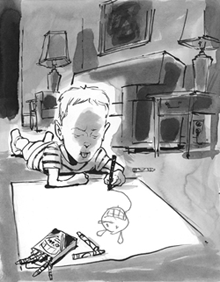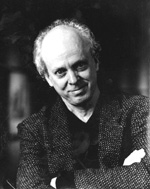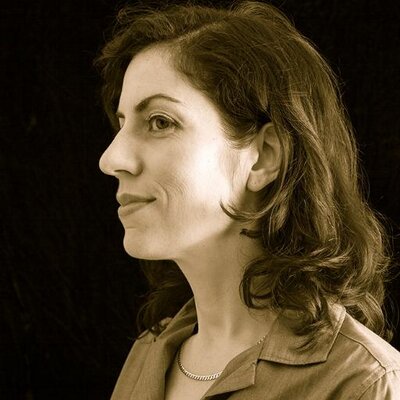David Small has made a career illustrating books for children. So it was no surprise that he should be the featured speaker on the last day of Harvard’s popular class, “History, Philosophy and Literature of Childhood,” taught by Maria Tatar. But on that chilly spring afternoon, standing in front of 190 eager undergraduates, he came to talk about a different sort of children’s book, a book about childhood intended for adults, a graphic memoir published last fall called Stitches.
Stitches is the harrowing account of Small’s childhood growing up in a 1950s Midwestern home where no one speaks. His mother expresses herself through the slamming of cabinet doors. His father pummels a punching bag in the basement. His brother beats on drums in his room. In this environment, the young David Small retreats into his art and into his imagination.
 At age 14, David goes into hospital to have a cyst removed from his neck. He’s told it’s a routine operation but when he wakes up, he has stitches from ear to chest, and only one vocal cord. For the next 10 years he can no longer speak in anything above a whisper. He later finds out that his cyst was cancer. But no one’s told him this. It’s the first of many secrets that are revealed to him or that he uncovers by accident.
At age 14, David goes into hospital to have a cyst removed from his neck. He’s told it’s a routine operation but when he wakes up, he has stitches from ear to chest, and only one vocal cord. For the next 10 years he can no longer speak in anything above a whisper. He later finds out that his cyst was cancer. But no one’s told him this. It’s the first of many secrets that are revealed to him or that he uncovers by accident.
A book about voicelessness and secrets lends itself to graphic form, and Stitches has been roundly praised. The Washington Post called it “brilliant and heartbreaking.” Library Journal wrote, “Small’s art lifts his memoir into the extraordinary.” Stitches was also short-listed for a 2009 National Book Award.
I was excited to get my hands on the book prior to Small’s talk at Harvard. But when I went to the Lamont Library, where the memoir had been held on reserve, I couldn’t check it out. Due to a kink with my borrowing privileges, I was told I couldn’t even remove it from the lending desk. “But I have to read it for class.” “You can read it over there.” The Librarian pointed me to an easy chair, situated five feet from the security desk, with its bright florescent light and constant parade of patrons.
I settled into my seat resentfully, and then I opened the book. Stark industrial landscapes in Detroit give way to an empty street where all of the homes look alike. The reader is then led into the open door of one of these homes, through the living room, where a young boy is drawing on the floor, and into the kitchen, where a woman is doing the dishes. “Momma had her little cough.” I was immediately sucked in. Three hundred and twenty-nine pages later, I lifted my head and found myself again in the bright light of the library entrance, blinking, disoriented.
I recently caught up with David Small by phone from his home in Michigan to talk about Stitches.
“Graphic novel” is a form that now encompasses all kinds of storytelling, fictional and factual. As someone who’s made a career as an illustrator, how would you compare reading pictures vs. reading words?
I wasn’t a fan of the graphic novel before I did one. I’ve always been interested in the worldless form, in picture books, but an entire novel in complex ideas and pictures? I’d not seen anything aside from Maus that made me want to try it. Then a Parisian friend showed me some graphic novels from his shelf. Here were some very sophisticated themes being dealt with and the art was terrific, much less raw than a lot of the stuff being done in America. That’s one of the problems with graphic novels. Who wants to spend 400 pages looking at what each picture means? You don’t often see good art and good story combined, and that’s what I saw happening in those French books. And I thought, “I can do that.”
Did Stitches come to you first in images, or in words?
It first came in memories, which are like images. But I had to write things out before I could draw them. I think that writing gives a kind of structure that images can’t. Writing is left-brained and drawing is right-brained. I think the left brain has the organizational frame work that helps to give the order to the chaos of memory that’s necessary to make a story that’s comprehensible to the reader, and also to the writer. I could draw all day but not in any form that would cohere.
Also, since I’m not a very good writer, drawing helped get me started. There was a tremendous relief because the visual language is much more my thing, my milieu. Also, because my story is about being wordless, being forbidden to speak as a child, and then having my voice taken away, the graphic form seemed perfect.
 The New Yorker compared your book to silent film. And in many ways, Stitches could be a storyboard for a movie.
The New Yorker compared your book to silent film. And in many ways, Stitches could be a storyboard for a movie.
Absolutely, but it’s not a movie. It’s a book that was influenced by film.
Who were the influences?
Bergman. Hitchcock. Polanski. Buñuel—his simple way of telling a story. Psycho is brilliant visual storytelling. The camera swoops into a particular building, then into a window. It carries the viewer. But there are writers who do this too. Flaubert will take you away from Madame Bovary’s room and take you into the landscape and the light, and it will tell you about the experience she’s going through. That was a cinematic technique he devised before there was any cinema.
During your talk at Harvard you described the importance of stripping away writing. How difficult was this for you?
I resisted it a first. It was my wife who kept saying, “You really ought to try paring this down to a silent book if you can.” I resisted. I felt dependent on language. But then I saw the sense of it and I made it my own. The words were so poorly done. It goes along with the whole problem of picture books if the author is not the illustrator. The author doesn’t need to say that the character has a bathrobe on if they have a bathrobe on in the picture. The author has to cut his precious text. I had to go through this process myself.
How did you decide what to strip away? How did you find your themes?
In your life everything and everybody is important. But to a reader they’re not. What helped me was my editor Bob Weil telling me to find leitmotifs and encourage the ones that I already had going. Alice in Wonderland was a leitmotif and it became a great connecting mechanism. The dreams are the connecting thing, too. Rather than picking my themes, it was a matter of recognizing them and discarding some of the subplots that seemed essential, but really weren’t.
In the memoir, you write about your desire, as a child, to escape through art. And the conclusion of one chapter shows an illustrated David Small actually diving into the page. But David Small the author creates this world through drawing. Was it hard to recreate and return to such a painful world?
Absolutely. It was very painful, and for that reason I was very reluctant to do it. That was the root of my problem. I was still caught in that world, in a way. My brother and I avoided each other for 50 years because neither of us wanted to be reminded of that world. I didn’t want to see him because I saw he was recreating the life we had in Detroit. He bought the same kind of house we grew up in. Furnished it the same. Married a hypochondriac. And he was just this sort of silent, passive aggressive guy, just like our family. I had no respect for that. And I hated seeing it in myself.
What was it like to recreate your mother in such a graphic way?
It was thrilling, in a way, to bring her back to life. The power of being able to resurrect the dead in a picture, as well as all of those places I can’t revisit because they don’t exist anymore. But seeing her on the page, scrutinizing my every move, I felt like she was going take my voice away. I felt it so strongly when I started drawing. And I began to get very tense.
It was during that time that [my wife] Sarah and I were at a restaurant. I was resting my hand on my neck and I could feel this swelling. The tumor, that had taken years and years to develop before, seemed to be coming back in a manner of minutes. I thought it was a hallucination until I saw Sarah’s face and she went pale. She could see it happening. She shoved a glass of wine at me and said, “Drink this,” and I did. Then I got up, went into the bathroom to check, and there indeed was this lump exactly like at 14. I realized at that moment that if I didn’t let it out somehow, it was going to kill me. This was proof. I would have died right there in that john if I hadn’t got a grip. This is not going to happen. I’m going to make this book.
How did authoring and drawing your story change your perspective on it?
When I was creating my mother and myself I suddenly realized the size difference. It really matters! When you’re six and you’re in that body, the grown ups look like giants. But then I drew myself and thought, “That little powerless thing. How could you treat a creature like that, who is so dependent?” It made me realize my position in a totally different way. I was not responsible for my mother’s unhappiness. I was just this little kid trying to be a kid and getting through the day.
You’ve illustrated many award winning children’s books including Imogene’s Antlers and The Gardener. How did your style of drawing change for Stitches?
First I eliminated color. We have such an emotional reaction to every color. To have to think about whether I should put in a red or ochre in every panel for 300 pages, it would have killed me. I wanted a black and white book, like the films of Bergman. To strip away color gets to the issues more directly. Then, I tried to develop a style that was more like handwriting. You can see my early books I can draw a hand like nobody’s business. But in Stitches it’s reduced to its gesture. I would do the gesture in a single line if possible, just to speed the process up and not be bogged down by making everything accurate.
Was it strange to go from tales of wonder to this darker story? Did you feel like you had to negotiate between two worlds?
Not for me. I had a foot in both worlds for my whole career. I was an editorial artist for magazines like The New Yorker and the Times for years. I wanted to be an editorial artist before a children’s illustrator, but it turns out my strength was in picture books. It was a relief to have the reins taken off [with Stitches]. Because when you work for kids you want to be careful about the language you’re using and the way you depict. Books can have dark humor, like Imogene. But the last thing I want to do is take away hope.
The afterward to Stitches was strangely moving. After getting to know your family as illustrated characters it was startling to see them in photographs, as real people, with their own histories, their own problems. Why’d you do it?
I think my first impulse was childish. I wanted to show everyone that I drew my mom and dad like they looked. Then I thought, wait… it’s an important thing to show the human beings behind the story. To see the people makes it easier to understand them. That’s the process that I went through. To go from feeling they were monsters to thinking they were doing the best they could. They really weren’t the malevolent beings I thought they were. I’m not saying the book was act of forgiveness, but an act of understanding close to forgiveness.
Your book is about secrets but in writing and touring this book you’re exposing those secrets to everyone. Is that strange for you?
It doesn’t bother me. They’re dead. The fact I walked in on my mother and her lover, that was something she was probably expecting all her life. In fact, a lot of people knew about it but couldn’t admit it to themselves. That’s the interesting thing about these secrets. They’re out in the light. It’s family and friends who willingly choose to ignore them.
Your parents were dead by the time you wrote Stitches, but your brother is still alive. What was his reaction?
I was forced to show it to him, in a nascent state, because of a publishing scandal that occurred three years ago, where a woman had lied about her memoir. The publisher lost a lot of money. My publisher was concerned that anyone who was still alive who shared my experience might have a different memory. I had to admit my terrible relationship with my brother and send him the book. He took me aback. “I love this book,” he said. “It’s a terrific story.” “What do you think about it as a family history?” “It’s a snapshot of my youth. It took me right back.”
How did it change your relationship?
We’re friends. We talk. We call one another. He’s quite a good film critic. I don’t know if we’ll be best friends, but we’re brothers again.
————–
Alysia Abbott is a writer and former WNYC radio producer. Her work recently aired on KRCC and has appeared in a number of anthologies and publications, including Time Out and Salon.com. She is currently working on a memoir about her own childhood.


